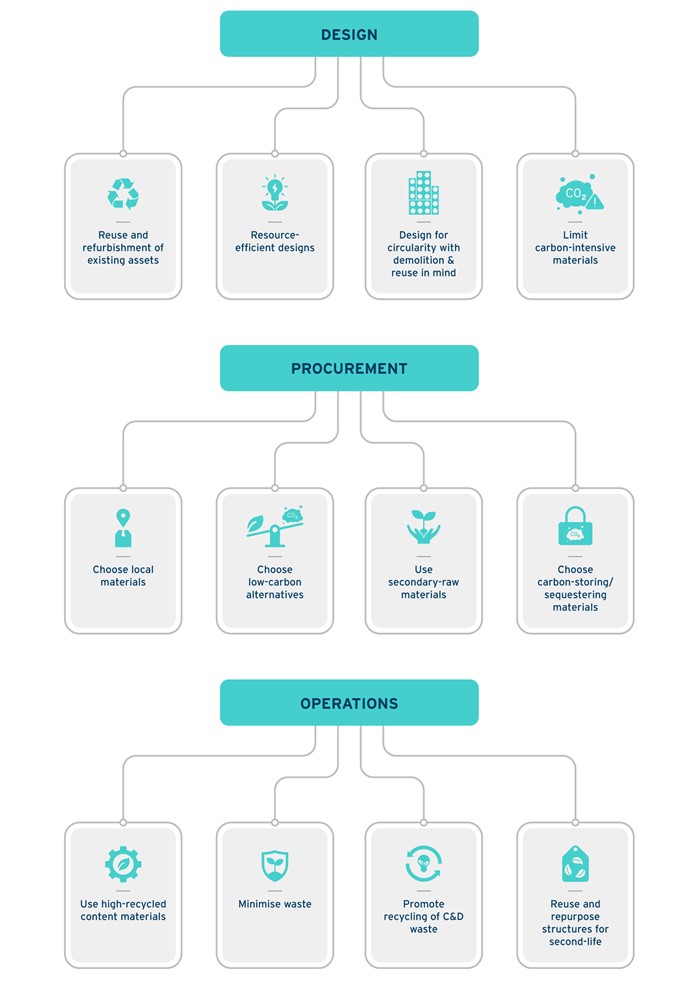
Reducing Embodied Carbon Is Key to Meeting India’s Climate Targets
While India’s buildings-related CO2 emissions have more than doubled between 2000 and 2017, the indirect emissions have almost tripled. These indirect emissions are the embodied carbon (EC) emissions associated with procurement, manufacturing, construction use, and disposal of building materials over the life cycle of a building. Globally, EC emissions will be responsible for almost half of total new construction emissions between now and 2050. Therefore, the buildings sector has a significant responsibility for reducing greenhouse gas emissions—which translates to a huge opportunity to create affordable low embodied carbon building materials. While India’s ambitious renewable energy targets and clean-energy momentum is already enabling the country to outperform its Paris pledges, the country must develop comprehensive sector-level decarbonization strategies to meet the recently announced climate commitments at COP26.
EC Emissions Reduction Targets Are Gaining Global Momentum
The environmental and material challenges associated with EC need nationwide attention, and decarbonizing the built environment across the entire life cycle is critical to meeting the 1.5°C target. In 2019, the buildings sector was responsible for around 38 percent of energy-related CO2 emissions globally and about 24 percent of total energy and process-related CO2 emissions in India. According to the Global Alliance for Buildings and Construction, if the buildings sector aims to be net-zero carbon by 2050, the impact of the decarbonization actions must be increased by a factor of five across the buildings’ value chain globally.
Fortunately, there is growing ambition from businesses across the built environment value chain, with leading companies announcing net-zero commitments. Manufacturers are launching low-carbon content building materials, not just to protect themselves against the risks of climate change but also to take advantage of the massive opportunities arising as the global economy shifts to net-zero emissions. Dalmia Bharat Cement, Ultra Tech Cement, ACC Cement, Ambuja Cement, JSW steel, Saint-Gobain, and Berger paints are some of the Indian companies with net-zero carbon roadmaps and environmental product declarations for their products.
Why Should We Act Now?
EC emissions have not been addressed at nearly the same scale as operational emissions and energy efficiency improvements in India. Operational carbon emissions can be reduced over time with decarbonizing the electricity grid and with energy efficiency retrofits. However, that won’t solve the whole issue if we keep constructing buildings the same way. Carbon-intensive materials and unsustainable construction practices could irreversibly lock in high energy use and inefficiencies for decades to come. Reducing EC emissions from the buildings sector will also significantly improve air quality across the country by reducing air pollution.
In the next 20 years, India’s CO2 emissions are projected to rise by 50 percent, which is the largest for any country. One of the key reasons for this increase is attributed to the buildings sector as India’s total building space is projected to more than double. Estimates suggest that between 40 and 50 percent of resources extracted across the world for materials are used for housing, construction, and infrastructure, and about 20–25 percent of India’s total energy demand comes from the building materials manufacturing industries.
The manufacturing of building materials is both a resource-intensive and an energy-intensive process. India is the second-largest producer of bricks, steel, and cement in the world. Reinforced concrete and steel frames underpin most of the construction in India’s buildings today—around 60 Mt of cement and 14 Mt of steel were consumed for India’s urban construction in 2020. The urbanization rate in India is expected to rise to 40 percent by 2030–31 and this massive urban transition underpins rapid consumption of energy‐intensive materials such as steel and cement. Here’s a brief snapshot of the projected demand and greenhouse gas emissions associated with these three sectors.
- In the next 30 years, India’s steel demand is estimated to more than quadruple, from around 111 Mt to 489 Mt, and the corresponding CO2 emissions are projected to rise to from around 300 million tons to 837 million tons.
- In the next 20 years, India’s brick demand is projected to multiply by three to four times and reach 750 billion to 1 trillion bricks/year. Brick kilns are responsible for about 66 million tons of CO2 emissions and other harmful carbon monoxide, sulfur dioxide, NOx, and particulate matter emissions across the country.
- India produced 337 million tons of cement in 2019, corresponding to ~250 Mt of CO2 By 2050, that could increase by three to six times. At the same time, the Indian cement industry aims to achieve a 45 percent reduction in emissions intensity by 2050 from its 2010 levels.
Solutions Exist!
IEA’s estimates suggest that deploying currently available EC solutions could reduce global cumulative CO2 emissions by 70 percent. A broad range of strategies can be adopted at various stages of project execution to reduce material demand and EC emissions in the built environment, as summarized below.

Fixing any one part of the built environment is not enough to stop climate change. Each of the many different parts need their own solutions. A whole-building life-cycle assessment and a whole systems approach is necessary to understand the EC emissions associated with a project. RMI’s recently released Concrete Solutions Guide provides an overview of proven scalable solutions to reducing embodied carbon in buildings. In a report titled Decarbonizing Heavy Transport and Industrial Heat, Amory Lovins details how steel, aluminum, and cement can be used more sparingly in the buildings sector using new design methods, technologies, materials, and business models. Additionally, with depleting natural resources, increasing the construction and demolition waste recycling rates and recovering valuable materials presents a great emissions reduction potential.
Furthermore, if planned correctly, buildings can be not only less carbon intensive but also carbon negative. Carbon Leadership Forum’s recent study on carbon storing materials shows that a 60 percent reduction in embodied carbon is possible in two to three years by bringing readily available low-carbon materials into wider use across the globe. Green building rating systems and even energy codes could also drive the demand for low-carbon materials. However, for all these solutions to be adopted at sufficient scale and pace, clear pathways have to be developed and implemented, quantified, and specifically aligned with energy and climate goals.
Mainstreaming the Future—The Need for a National-Level Strategy
The resources and affordability crunch, in conjunction with the congestion from urbanization, provide the perfect opportunity in this climate crisis to develop a national-level strategy to decarbonize the built environment. The Government of India has been implementing several policies and initiatives to promote the use of sustainable building materials, and the net-zero pathways embodied in today’s policies should be realized in full.
Having a national-level narrative and roadmap to net-zero carbon buildings— including embodied energy and carbon—will be central to India’s sustainable economic development. It would create certainty; address any gaps in the supply, demand, and finance aspects; and drive market transformation. Decarbonizing the built environment is a profitable business, and if done strategically, can amplify the financial and environmental benefits to India. This is a leapfrog opportunity for India to be a world leader in developing capacities for manufacturing low-carbon materials and compete in the global supply chains. India can show a whole group of energy‐hungry developing economies a decarbonization pathway where robust economic expansion is fully compatible with emissions reduction.